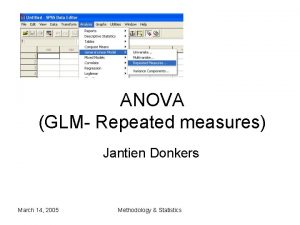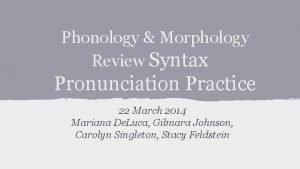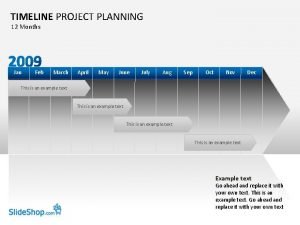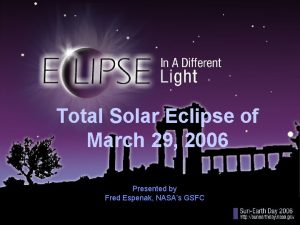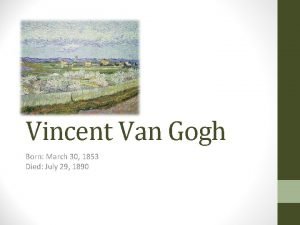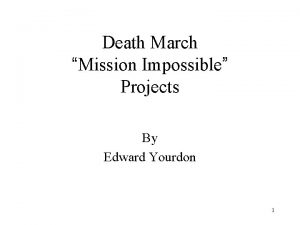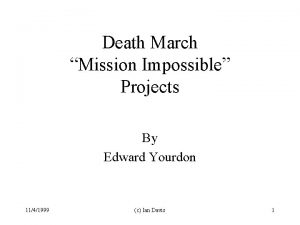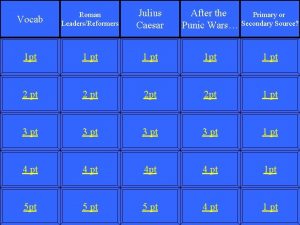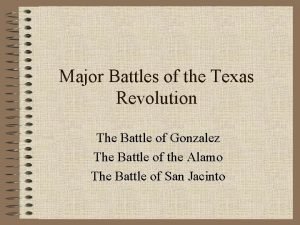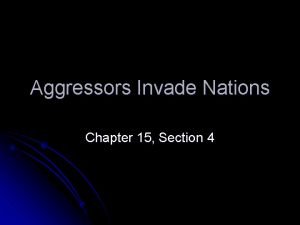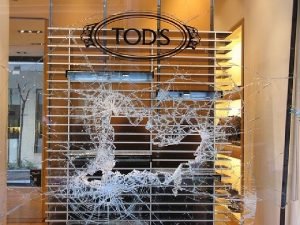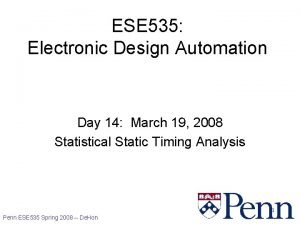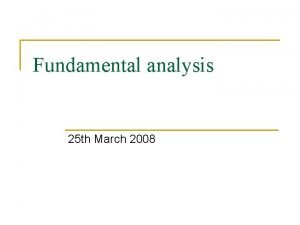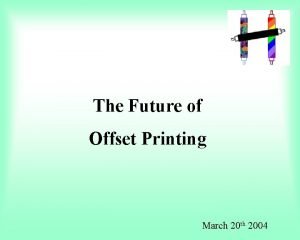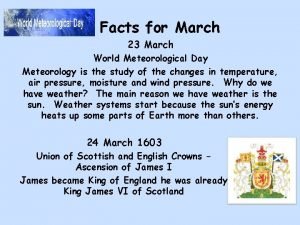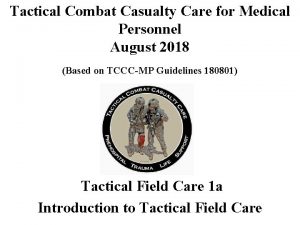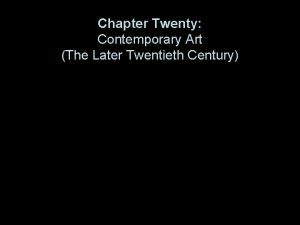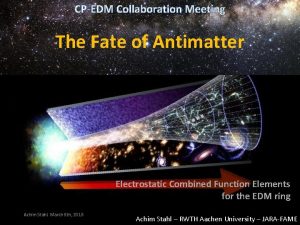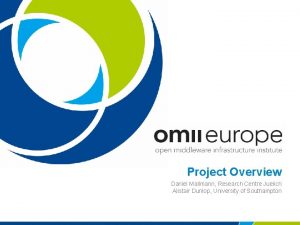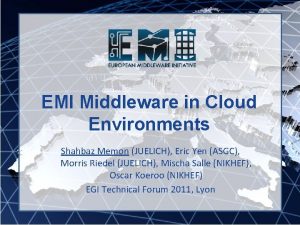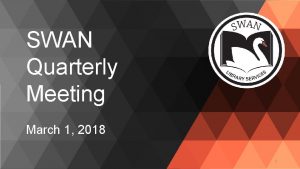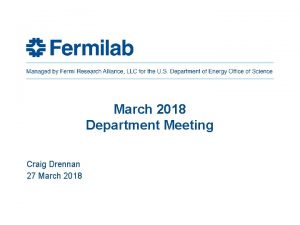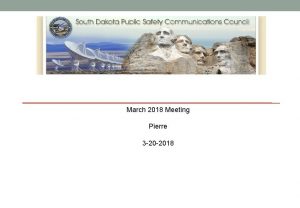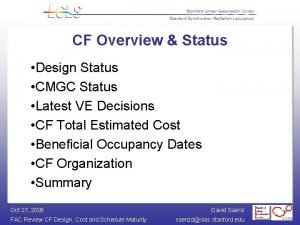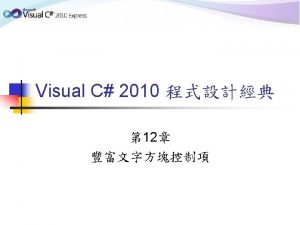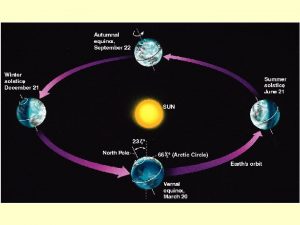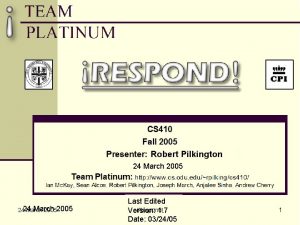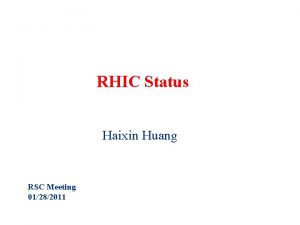8 March 2018 CPEDM meeting Juelich Status of












































- Slides: 44

8 March 2018 CPEDM meeting, Juelich Status of Storage Ring EDM Yannis Semertzidis, CAPP/IBS and KAIST The view from Korea • Keep it simple, prioritize with proton • Precision physics frontier, great physics reach, probing NP ~103 -104 Te. V • R&D critical phase coming together, getting ready to design a functional ring 1

Review of Scientific Instruments 87, 115116 (2016) 2

The proton EDM electric ring, 500 m circ. Straight sections are instrumented with quads, BPMs, polarimeters, injection points, etc, as needed. Requirements: Weak vertical focusing (B-field sensitivity) Below transition (reduce IBS) 3

Critical R&D projects • SQUID-based BPMs, at <10 f. T/sqrt(Hz) level • Characterize its functionality, time stability • Magnetic field shielding <10 n. T • Geometrical phases: 1. magnetic, 2. electric • Study with precision simulation tools • Clearly define lattice elements specs, what is possible with beam-based alignment 4

Critical R&D projects, con’d • Develop a robust polarimeter: deadtime-less, point back to origin, high efficiency, high analyzing power • Have an answer: what else can we do with this facility? Axion-dark matter: Axion-EDM project • Reliable, cheap E-bending plates: Ti. N-coated aluminum plates (follow J-LAB work & scale up) 5

JLab results with Ti. N-coated Aluminum No measureable field emission at 225 k. V for gaps > 40 mm, happy at high gradient Matt Poelker, JLab Bare Al Ti. N-coated Al We need <10 MV/m for 30 mm plate separation 15 MV/m 20 MV/m the hard coating covers defects Work of Md. A. Mamun and E. Forman 6

7

Projects in Korea • Magnetic field shielding, SQUID-based BPMs, IBS/CAPP, KRISS, TUM, … • Teamleader: Selcuk Haciomeroglu • Goal: develop a SQUID-based BPM at the 110 f. T/sqrt(Hz) level • Characterize it at IBS/CAPP for time stability • Install it at a ring for real-time testing 8

Projects in Korea • Schedule, SQUIDs: 1 full scale unit ready for testing at IBS/CAPP: fall 2018. • Ready for installation for testing at a storage ring in 2019 9

Beam position monitor: SQUID array Liquid He Vacuum SQUID magnetometer To p-beam line 10

Cylindrical Dewar: under fabrication 11

SQUID-based BPM development Subjects Category 2014 2015 2016 2017 SQUID magnetometer and control electronics system Pretest SQUID system Low-noise SQUID system for p. EDM Research outcome 2018 2019 Ultra-low-noise SQUID magnetometer and control electronics system Hollow cylindrical dewar, Superconductive shielding, optimization 16 ch SQUID system optimization 8 -ch SQUID system, 3 f. T/Hz 16 ch SQUID system, system noise 3 f. T/√Hz (@ 1 k. Hz) System noise 2 f. T/√Hz 1. 5 f. T/√Hz (@ 1 k. Hz) 12

Projects in Korea • Schedule, Magnetic shielding: 1 full scale unit under test at IBS/CAPP. • Improve shielding factor of magnetic shielding room in 2018 • Finish time stability tests in 2019 13

Selcuk Haciomeroglu, Andrei Matlashov et al. Two-layered system, time drift tests limited by environmental noise Achieved so far: Absolute field: <10 n. T, limited by gradients and drifts Improving our shielding room to study the effects… 14

Projects in Korea • Precision beam and spin dynamics • Teamleader: Selcuk Haciomeroglu • Goal: establish specs of lattice elements (2018) • Schedule: work with Martin Gaisser et al. , in monthly beam/spin dynamics meetings • Work with Sieg Martin towards a practical lattice 15

Projects in Korea • Polarimeter-related systematic errors • Teamleader: Seong. Tae Park • Goal: implement a reliable spin dependent cross section in GEANT 4 for systematics studies • Collect the proton polarimetry data at COSY • Develop a reliable, GEM-based polarimeter for sr. EDM exps. • See talk by Seong. Tae Park on March 6 16

Projects in Korea • Axion-EDM project • Teamleader: Seong. Tae Park • Goal: establish best sensitivity to generic axion dark matter for low frequency range • Axion oscillation frequency on resonance with g -2 frequency of proton/deuteron • Use current COSY ring for <30 MHz range (even RF-Wien filter works with less sens. ) 17

Electric Dipole Moments in Magnetic Storage Rings e. g. 1 T corresponds to 300 MV/m for relativistic particles 18

Indirect Muon EDM limit from the g-2 Experiment z B y s β x Ron Mc. Nabb’s Thesis 2003: 19

Horizontally there’s a g-2 precession and vertically a regular spin buildup (axion/g-2 resonance) 20

Projected experimental sensitivity 21

Systematic errors (or how do we do the experiment!) • Vast literature available from the sr. EDM collaboration web sites: • • What cancels CW vs. CCW (1996) Spin Coherence Time (Yuri Orlov, 2000 -2004) Clock wise (CW) and Counter CW stores Corrugated particle orbits aka “Twist” and “Saucer” effects (2002, 2003) 22 • Geometrical phases (2002)

Toolkit against systematic errors • CW vs. CCW (advantage: proton EDM ring is at same time) • Positive vs. negative helicity for polarimeter systematic errors • Spin at radial direction to maximize effects from distortions (no EDM effect) 23

Lattice and systematic errors • Some lattices are (much) better than others! • Best (for systematic errors): continuous weak focusing machine • Next best: focusing and E-field bending at same location • Next next best: separate (soft vertical) focusing and E-field bending • Next next best: separate (strong vertical) focusing and E-field bending. Do not despair!24

Putting together the experiment • Mechanically place all elements to 0. 1 mm local resolution (or as well it is possible) • Using button BPMs (or Rogowski coils, TBD) to achieve resolution at the 1 micron level (Tim Wagner you have a secure job!) • Run the experiment with 90 & 180 degrees (radial) spin direction. Use vertical E-field trim plates around the ring to cancel the effect of 25 distortions

Running the experiment • Modulate the quads by somewhere between 110% all at same frequency (for SQUID-based BPMs) • Modulate each quad at its own freq. by 0. 1%. • Use the radial spin direction bunches to keep system aligned with trim E-fields • Use SQUIDs or longitudinal spin direction bunches to keep the average radial B-field to 26 zero

New by Yu. Senichev: Running the experiment • Under certain conditions CW vs. CCW cancels ring distortions. (Note: Not all!) • We will work with Yu. Senichev to come up with a possible lattice to use the Frequency Domain Method • Possible advantages (need to confirm): SCT; Some forms of Geometrical phases • Still need low vertical focusing to cancel radial B 27 -field effects

Yu. Senichev’s slide 28

Summary • The physics of the storage ring EDMs is strong. Now even stronger • Keep it simple, start with proton, all electric ring • Critical items are mature and ready for prime time: SQUID-based BPMs, magn. shielding, GEANT 4 & Polarimetry, Axion-EDM • Precision beam/spin dynamics simulations to help finalize the lattice designs • Write-up on systematic errors by end of 2018. 29

Extra slides 30

Yu. Senichev’s slide 31

Storage ring EDM: The proton • • • High intensity sources (~1011/fill) High vector polarization (>80%) High analyzing power for 0. 7 Ge. V/c (233 Me. V) Long spin coherence time possible (>103 s) Simultaneous CW & CCW storage 32

Proton Statistical Error (230 Me. V): τp : 103 s Polarization Lifetime (Spin Coherence Time) A : 0. 6 Left/right asymmetry observed by the polarimeter P : 0. 8 Beam polarization Nc : 1011 p/cycle Total number of stored particles per cycle TTot: 107 s Total running time per year f : 1% Useful event rate fraction (efficiency for EDM) ER : 7 MV/m Average radial electric field strength σd = 1. 0× 10 -29 e-cm / year 33

Peter Fierlinger, Garching/Munich Under development by Selcuk Haciomeroglu at CAPP. Need absolute field: few n. T Need gradient field: ~n. T/m 34

Proton systematic errors case 1. Main systematic error (radial B-field) is well under control: measure dsv/dt and vertical split of beams at 1 k. Hz. 2. Geometrical phase for B-field: CW vs CCW cancel! 3. B-field shielding: few n. T, well under control 4. E-field specs: 100μm placement, 10μm using beam based alignment? 35

Status 1. Proton systematic error studies show great promise, coming to conclusions soon. 2. Deuteron questions: 1. Ev stability, including when B-field is reversed 2. Level of local cancellation with mixed E and B-fields (Geometrical phases) 3. Patch effect from E-field plate surfaces. 4. Complications from Tensor polarization? 36

Spin Coherence Time: need ~103 s • Not all particles have same deviation from magic momentum, or same horizontal and vertical divergence (all second order effects) • They cause a spread in the g-2 frequencies: • Present design parameters allow for 103 s. • Much longer SCT with thermal mixing (S. C. )? 37

Technically driven p. EDM timeline 2015 16 17 18 19 20 21 22 23 24 • Research and systems development (R&D); CDR; final ring design, TDR, installation • CDR end of 2018 • Proposal to a lab: fall 2020 38

Geometrical Phases in Deuteron EDM Example from the proton case: S s t e h t ra t c tri … s c e p s s r e 39

Geometrical Phases in Deuteron EDM Ground motion: Coherence up to 90 -120 m apart. 40

Geometrical Phases in Deuteron EDM Ground motion: FNAL MINOS hall 41

Geometrical Phases in Deuteron EDM Ground motion: FNAL MINOS hall 42

1. Symmetries 43

2. Specs a) Leakage currents: <1μA b) Power Supply stability (on average): <10 -4 c) Net heat source in enclosed ring: <(± 20 kwatt) d) Average field uniformity over 2 cm diameter: ~1 ppm 44
 Poland national anthem lyrics
Poland national anthem lyrics Azure bug bounty
Azure bug bounty Dada la siguiente secuencia rusia 2018 rusia 2018
Dada la siguiente secuencia rusia 2018 rusia 2018 Nrg oncology meeting 2016
Nrg oncology meeting 2016 Nrg oncology meeting 2017
Nrg oncology meeting 2017 Aua meeting 2018
Aua meeting 2018 What is meeting and types of meeting
What is meeting and types of meeting What is meeting and types of meeting
What is meeting and types of meeting For today's meeting
For today's meeting Today meeting or today's meeting
Today meeting or today's meeting March
March American idol
American idol March verb
March verb What is ngo
What is ngo Jan feb mar
Jan feb mar March 7, 2012
March 7, 2012 Why is the long march important
Why is the long march important Astronomy picture of the day march 29 2006
Astronomy picture of the day march 29 2006 Sigma gamma rho march of dimes
Sigma gamma rho march of dimes When was van gogh born and died
When was van gogh born and died Death march edward yourdon
Death march edward yourdon Death march edward yourdon
Death march edward yourdon March madness dataset
March madness dataset Sherman's march to the sea
Sherman's march to the sea Ides of march punic wars
Ides of march punic wars 4th joyful mystery images
4th joyful mystery images Path of sherman's march to the sea
Path of sherman's march to the sea Texas revolution battles map
Texas revolution battles map March kindergarten newsletter
March kindergarten newsletter March 1, 1803
March 1, 1803 There's a royal banner given for display
There's a royal banner given for display Chapter 15 section 4 aggressors invade nations
Chapter 15 section 4 aggressors invade nations Glasgow 5th march 1971
Glasgow 5th march 1971 535 before 14 march
535 before 14 march 25 march 2008
25 march 2008 Offset printing march
Offset printing march January february march season
January february march season March 2013
March 2013 Jan rose kasmir
Jan rose kasmir March 7 2008
March 7 2008 March 23 world meteorological day
March 23 world meteorological day March algorthym
March algorthym Just bingo
Just bingo Genetic engineering conclusion
Genetic engineering conclusion Performance art
Performance art










